I have recently received a small Aloe plant that I wasn't able to identify past the genus. It does not look healthy, some leaves have become brownish, and their ends thin, as if squeezed out.
The plant is an offspring that has been separated and repotted in an IKEA substrate made of coir/coconut husk. This question describes the thinning and the answers identify a possible culprit in the soil, which I plan to substitute with the mix suggested in the accepted answer in this question.
What I wasn't able to find an answer to is the browning. It is likely that after repotting, the plant has received little to no sunlight for a month. Currently it receives a half day of sunlight (as much as Denmark can offer, anyway). Could the browning be related to sunlight deficiency(or excess)?
Another possibility I have considered is watering. I try to water according to the accepted answer here, but the soil type might be offsetting that. Should I adjust the watering to fit better with the temporary soil mix?
And finally—in case my assumptions are missing the mark—what other reasons there might be behind the browning and thinning of the leaves? Can I expect a recovery?


